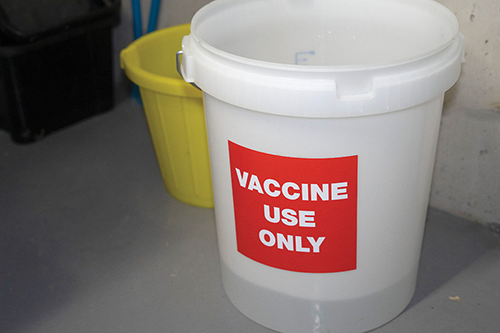
- 5.2.2024
- Education
Vet Times – correct live vaccine administration for pigs and poultry
In-water vaccines can provide a range of benefits for pig and poultry farms. However, they must be administered correctly to realise their full potential and, therefore, when out on farm, it is important we remind farmers of the best way to administer them.
The author has been successfully working with poultry farmers for many years to optimise in-water vaccination, with recent trials demonstrating positive results on pig farms, too.
In-water vaccination allows farmers to vaccinate a large number of animals without physically having to handle each one.
Around 90% of all vaccines given to commercial poultry are delivered via the drinking water, and vaccinating young pigs this way is a viable option. It offers a stress-free alternative to more conventional methods, as the technology and equipment now available to farmers makes automatically dosing drinking water with a vaccine relatively simple and cost-effective.
Benefits
When used correctly, in-water vaccines can provide huge benefits to both pig and poultry farmers.
As an example, free-range egg producers in the past have shown that an improvement in vaccination protocols can result in increased production.
When the author has worked with producers to make changes to improve vaccination efficacy, flocks have yielded an extra five eggs per hen, which on a 32,000-bird site equates to 150,000 eggs.
If farmers were being paid £1 a dozen, they would yield an extra £13,000 from vaccinating correctly – so, the benefits of maintaining bird health and performance for longer really does extend to producers’ pockets.
On pig units, in-water vaccination can be used to help control enteric diseases, such as post-weaning diarrhoea (PWD). Controlling enteric disease in post-weaned piglets often relies on in-feed treatments, antibiotics or zinc oxide medication.
Used strategically under veterinary guidance, these therapies will effectively control PWD. However, under continued pressure to reduce antibiotic use, and with the zinc ban now in place, more vets and pig farmers are exploring alternative ways to prevent PWD.
The author recently worked on a trial helping several pig farmers establish in-water vaccination programmes, using a particular live vaccine, to protect newly weaned pigs against F4 and F18 enterotoxigenic Escherichia coli scours.
The piglets were vaccinated via their drinking water between 18 and 25 days old, eliminating the need for another injection around weaning and providing protection against PWD. It was relatively easy to implement, and minimal labour was required. The vaccination strategy used in the trial has shown good outcomes in terms of disease control and performance.
Best practice
When out on farm, it is not uncommon to see farmers fall foul of common mistakes during the administration of in-water vaccines, thus reducing their efficacy. So, it is important to provide farmers with advice on key areas such as storage and handling of vaccines, water quality, drinker and pipeline hygiene, the water-to-vaccine ratio and vaccination timing.
Below are the author’s recommendations for pig and poultry farmers.
- Storage. All vaccines should be stored in a fridge with a temperature of between 2°C and 8°C. Vaccine efficacy will be impacted by temperatures outside of these parameters, so a minimum and maximum thermometer should be installed inside the vaccine fridge and checked daily.
- Water line hygiene. Water lines must be kept clean and have a neutral pH of between 6.8 and 7.2 before the vaccine is introduced, and for the duration of the treatment. The water must be free from contaminants, antimicrobials or a heavy mineral content – such as high iron levels – which is common with borehole supplied sources.
- Water sanitising systems. All sanitising agents, or any acidifiers used to control biofilms or microbial activity, must be completely flushed out of the water system before a live vaccine is introduced. The presence of any sanitising chemicals, such as chlorine or hydrogen peroxide, will kill off the viral constituents of a vaccine.
- Water to vaccine ratio. Failure to get the right water-to-vaccine ratio will result in some birds or pigs not getting any vaccine. The correct ratio should be precisely calculated based on the number of birds or pigs in the shed.
- Vaccination timing. As with all types of vaccination, timing is key. The birds or pigs must be given the in-water vaccines based on them having enough time to develop immunity before the disease challenge is present. This will vary depending on the vaccines used
- Water stabiliser. The use of a stabiliser can help stabilise the pH of the water supply and create a safe medium for a vaccine to be mixed into. Some also add a blue tone to the water, so farmers can see that the vaccine solution is being supplied throughout every waterline.
- Palatability. This is especially important for pigs, and the in-water vaccination pig trials showed that adding an aniseed-flavoured electrolyte to the vaccination solution massively increased water uptake in weaners.
Vaccines are a significant input cost, so it is important to work with farmers to ensure they are used properly to prevent waste and maximise flock or herd health and performance.
In-water vaccines are an effective way of treating pigs and poultry, as long as all stages of the process are correctly followed and, therefore, investing some time to get the process right will certainly pay dividends.